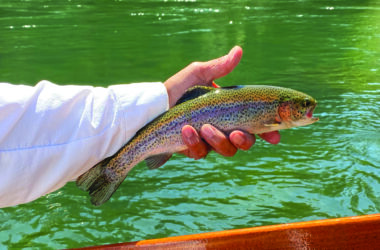 PHOTO COURTESY OF THE ARMY CORP OF ENGINEERS
PHOTO COURTESY OF THE ARMY CORP OF ENGINEERS
Detroit Dam creates the largest lake in the Willamette Valley, completed in 1953. It is one of 13 Army Corps dams built in the Willamette basin with no passage for migrating fish. Court-ordered changes should open miles of salmon and steelhead habitats above the reservoirs.
My recollection of fishing in Oregon and specifically here in Lane County reaches over 40 years and many of them were spent guiding fishermen. I recall a lot of years with a strong run of salmon and steelhead through our local rivers. But for those of you who regularly read my column, my disappointment in the low numbers of salmon and steelhead that have returned to the Willamette River basin in recent years is not news. Going on my third year of reporting for you I’ve never once had the opportunity to describe the local salmon and steelhead fish as “hot” “great” or even just “good.”
But a ruling by Federal District Court Judge Marco Hernandez last week, in a lawsuit brought by several angling and conservation groups, will likely have a profound impact on the future of salmon and steelhead in our local rivers. At its core the ruling has the potential to dramatically increase the numbers of salmon and winter steelhead in the Willamette Basin by opening hundreds of miles of habitat that were blocked when the flood-control dams were erected in the Willamette Valley.
Historically, every year for eons, almost 200,000 spring salmon climbed the falls at Oregon City headed to the Sanitam, McKenzie, Willamette, and their tributaries. Before 1880 there was no ladder at the Willamette Falls; the fish did fine without one and at the peak of the run daily, thousands of salmon would make the leap to head home to rivers we all know that before 1940 had no dams; Fall Creek, Row River, Brice Creek, the Coast Fork of the Willamette, the South Fork of the McKenzie, (along with many others) and of course the McKenzie and Middle Willamette would all teem with salmon every spring. In rivers that ran free of dams but often flooded and at times caused extensive damage to towns like Eugene, Springfield, Corvallis, Albany, etc.
Octogenarians may recall the time before the dams were built and when huge portions of the valley could look like a giant lake after a heavy rain or in years with a big snow melt. Without the mitigating structures our success as a state, culturally and economically, would have surely been stifled. In 2021 and going forward the dams are obviously essential and protect what are now our largest population and economic centers.
But the plans to prevent flooding were shortsighted from the beginning and all of the 13 dams that were erected by the U.S. Army Corps of Engineers were built without passage for migrating fish. To mitigate the blockage of their habitats the Corps opted to build a series of hatcheries to produce salmon who’s spawning potential had now been greatly reduced. No longer able to reach their spawning grounds, their numbers began to plummet. Specifically, spring salmon and winter steelhead – and the lack of passage – was cited in the listing of Willamette River winter steelhead as a “threatened” species way back as 1999. Sadly, after 23 years of inaction by the Corps, Willamette River winter steelhead still maintain that dubious status. Bull trout, wild trout, lamprey, sturgeon and other fish also had their migration routes blocked by the dams that were built and their numbers have also declined.
A lot of people would like to see more fish produced at the Corps’ hatcheries for release in the Willamette and would have the Corps or State of Oregon build more hatcheries. Sounds easy enough … but the hatcheries currently in place are as old as the dams. Once-gleaming models of ingenuity have become inefficient dinosaurs that are expensive to run and maintain. And from being directly involved in the fight to keep Leaburg Hatchery funded and running on the McKenzie, the fact is politicians have very little appetite to direct tax dollars for the construction of new ones. By the way, funding for Leaburg runs out by 2022..
When I think back to the 1980s, the winter steelhead run in the Middle Willamette and in Fall Creek was still as good as any on the coast. The winter steelhead swam right through downtown Eugene and Springfield and dozens of steelhead would stage at the mouth of Fall Creek, waiting for the water to rise to make their final push into Little Fall Creek. Which is their last haven in the southern valley. Frustrating to many anglers is that commonly accepted science told us for years that the lack of fish passage was one the major contributing factors in what has become a precipitous decline of migrating fish in the entire Willamette Basin.
Finally changes are on the horizon …
I’ll disclose that I am a life member of the Association of Northwest Steelheaders. My advocacy for fishing resources has always been centered around my participation in the organization and we were supportive and part of the lawsuit against the Army Corps to drastically change and repair the operation and physical configuration of their Willamette Valley flood control projects to provide effective passage for migrating fish.
Representing Steelheaders from the Southern Valley I was at the Oregon City Library several years ago with members of the Native Fish Society, Trout Unlimited, Northwest Guides Association, McKenzie Fly Fishers, and others who came together to develop strategy to hold the Corps responsible for the decline of significant cultural and economic entities iconic to the Pacific Northwest. Our collective goal is to return in combination of hatchery and wild salmon 100,000 fish to the Willamette Basin and stabilize winter steelhead numbers that have teetered on extinction for the past two decades. It should be noted that two years prior, all these conservation and fishing groups were locked in a bitter lawsuit over wild salmon escapement on the McKenzie and put those differences aside in a show of unity around a larger goal.
The ruling by Judge Hernandez is significant because it will likely affect every water user in the Willamette Valley, and in particular recreational and agricultural users. The full extent of the ruling is yet to be understood but for certain much of it will be defined by the availability of freshwater resources – which in Oregon is directly related to how much rain falls each year.
A larger explanation of Hernandez’s ruling is on my business Facebook page “River Trail Outfitters.” Hernandez ordered several “interim” operational changes that will likely begin this fall:
* Conducting winter and spring downstream passage operations at Fall Creek Dam.
* Analyzation of landslide risks associated with a deep drawdown at Lookout Point.
* Spill operations at Lookout Point Dam and Dexter Dam.
* Fish passage and water quality operations at Detroit and Big Cliff reservoirs, including considering using lower regulating outlets at Detroit Dam.
* A deep drawdown at Cougar Dam.
* Out-planting of adult Chinook salmon above Green Peter Dam.
* Spring and Fall spill operations at Foster Dam.
I am excited to see how the Hernandez ruling plays out but for the first time in a long time, I am optimistic about salmon and steelhead in our local rivers.
Email: [email protected]








